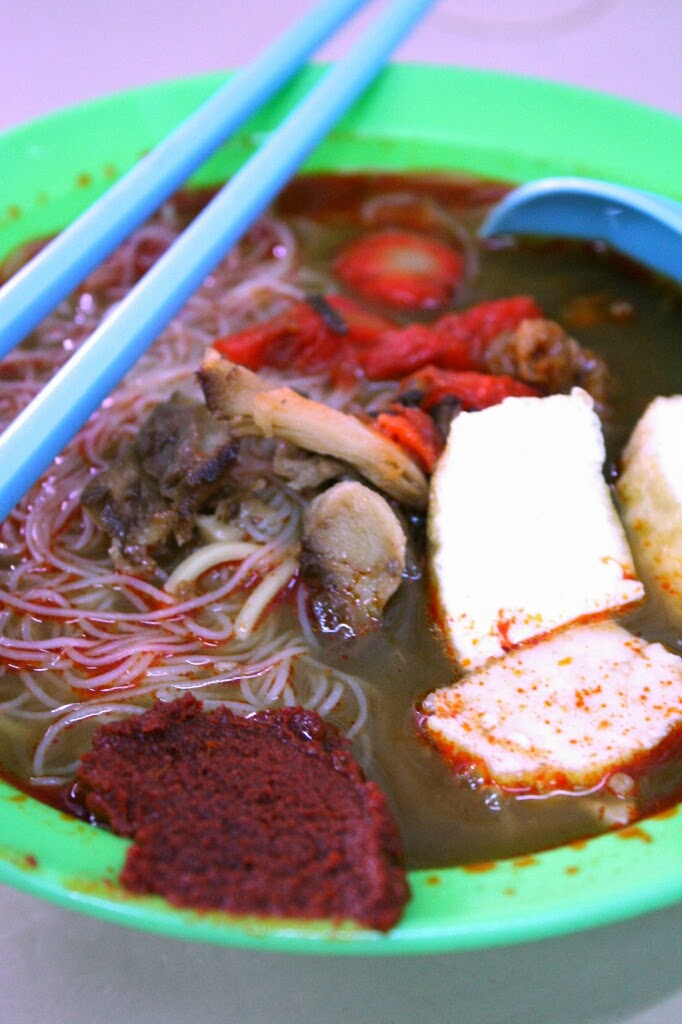 |
| Hokkien mee |
Today it was Hokkien mee. To be more specific, it was Hokkien hae mee, which is served as a soup in Penang, as opposed to Hokkien char mee, which is a stir-fried dish. Both variants traditionally involve prawn and are named after the Chinese dialect spoken by many of the diaspora in SE Asia.
The vegetarian version we ate this morning had a brown savoury broth that worked well to emulate the prawn-based equivalent. The soup hid the usual thick and thin rice noodles as well as pieces of mock meat and tofu. With chilli paste (sambal) on the side to add to taste, it was a wake-up for the senses. Tomorrow: curry mee!
In each place we have stayed on our trip thus far, there has been a cat - sometimes multiple. Either owned by our host, our next-door neighbour, or wandering in stray from the streets to deliver a litter of kittens in the cupboard, we have always had feline company. That is until now. Our accommodation is catless, but is perfect in every other way - well located, friendly, clean and tidy (possibly owing to the lack of pets). K especially misses a cat to stroke, so we headed to Penang's first 'cat café'.
 |
| Cat-eaux |
As we enjoyed the requisite cake and coffee (no, it really was required to buy these as the entry fee), signs on the wall were at pains to inform us how 'not weird' this set-up is, and that in Japan it is customary for the petless to hang out in similar cafés. We have been to Japan, and to a cat café there - it was weird.
 |
| Cat-ppuccino |
Still, K was insistent that we spend some time there and so, lured by the cake, I endured her attempts to rouse clearly affection-weary sleeping cats. Unlike the strays, which are hungry for love and, if not too timid, prostrate themselves at one's feet, these cats were fed, fluffy and pampered.
 |
| Grumpy cat is grumpy |
On our walk up and down Kimberley Street, we have passed Hameediya on several occasions and often a man with an expansive grin and arms outstretched has beckoned us in, bellowing "Delicious food!". I didn't doubt that this was true, so I insisted that we make a detour there prior to (re)visiting the mosque.
 |
| Roti telur |
Although not a pure vegetarian place, Hameediya, like most Indian establishments, offers plenty of choice alongside tandoori goat. Roti telur was our choice for a quick snack. This is the famous thin roti bread stuffed with egg (telur) as it is cooked on a hotplate. Served with a sambar and red onions, it made a slightly more substantial meal than intended. Raw onions are not to my taste, but these were lightly pickled in lime juice, which takes the horrid metallic taste out of them.
 |
| Inside the mosque |
We returned to Masjid Kapitan Keling for an informal chat about Islam with a volunteer in the information centre, prominently located in the base of the minaret. I applaud the mosque's openness and willingness to engage with non-Muslims about their faith.
We spoke to the man for over two hours about various aspects of Islam and Christianity, but also of Judaism and Hinduism. He struck me as similar to the eponymous protagonist from Life of Pi, as he was similarly intelligent and well read, and familiar with not just the tenets of the major religions, but seemingly conversant with large swathes of scripture from each of them. From initially being taken to a Christmas service, he investigated the fundamentals of several religions, and eventually chose to follow Islam.
The discussion was interesting and insightful, and covered the similarities and relationships of three monotheistic faiths, Judaism, Christianity and Islam in a way that was theological and not judgemental.
Muslims recognise a number of prophets, from Noah, through Jesus, to Muhammed, where the latter is believed to have brought the final, inerrant word of God. I marvelled at our guide's conviction that no prophet can have followed Muhammed, given that he also subscribed to a theory that allows for a series of flawed messengers that preceded him. Of course, I didn't entertain such obviously blasphemous questions in the discussion, but our guide himself brought up the notion, asserted by sects such as the Bahá'í and Cao Đài, that follows such logic to its natural conclusion - if a message is periodically delivered to mankind from a supernatural and singular entity (God) via a series of earthly prophets, the message can be expected to be contextual to the culture and environment of the time of each prophet's life. Therefore, there have been and will continue to be messages and messengers. It's a compelling argument, but one which does not persuade our guide nor others who follow more orthodox religions that allow only for fixed doctrine, delivered through scripture, with any interpretation permitted through exegesis by religious leaders.
In the evening, we returned to Ee Beng - not for their vegetarian buffet, but for a bowl of noodle soup.
 |
| Asam laksa |
Asam laksa (also called Penang laksa) was in the pot today and is a speciality of the island. Unlike the kind of laksa with which I am familiar, this version does not include coconut milk, instead being soured with tamarind (asam jawa), and spiced using lemongrass, and galangal, with fine slivers of pineapple, cucumber, lettuce, fresh mint, and thick udon-style noodles, made of rice. Normally being a fish-based soup, it was nice to be able to sample this specialty. A day bookended by noodle soup.
No comments:
Post a Comment